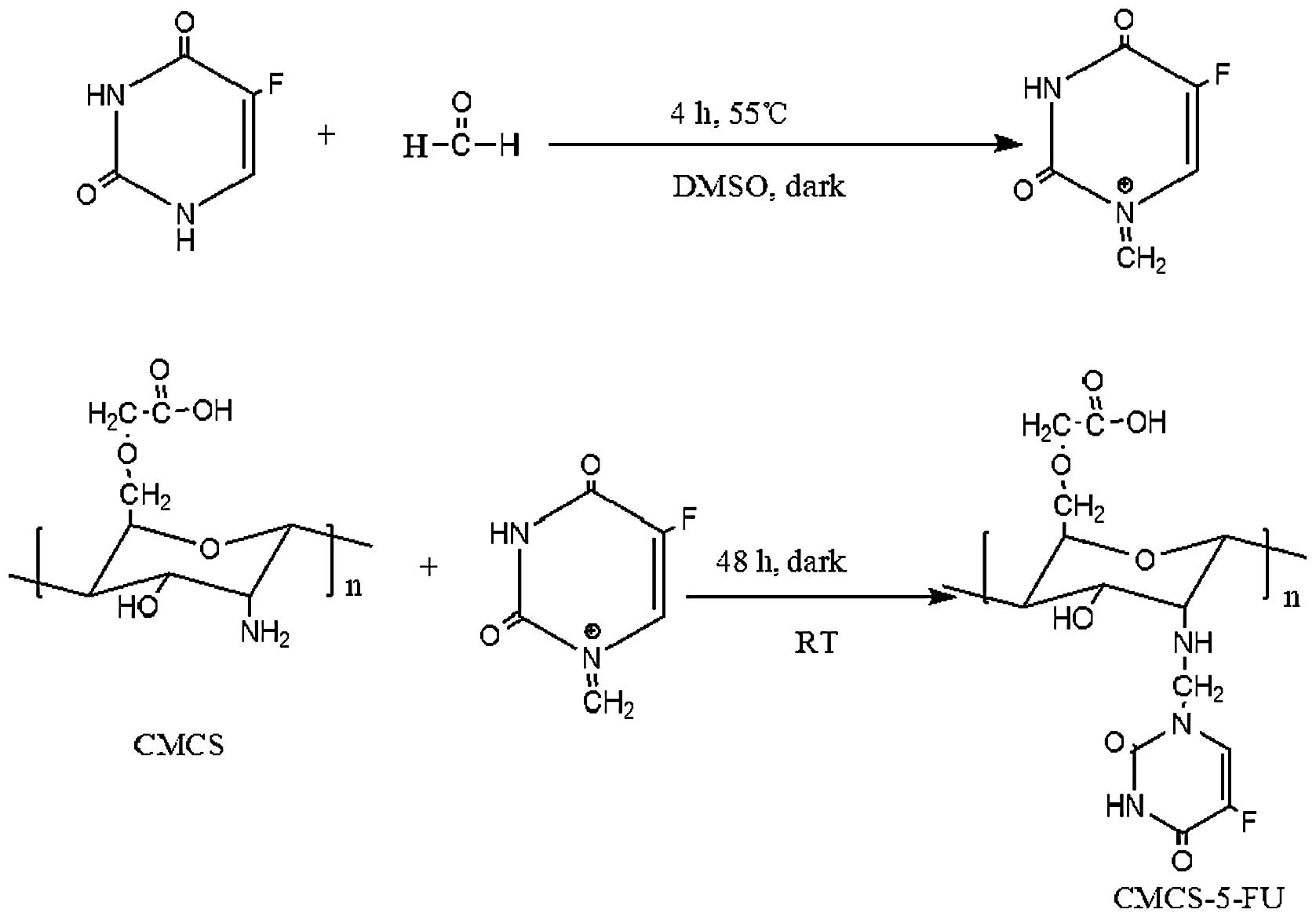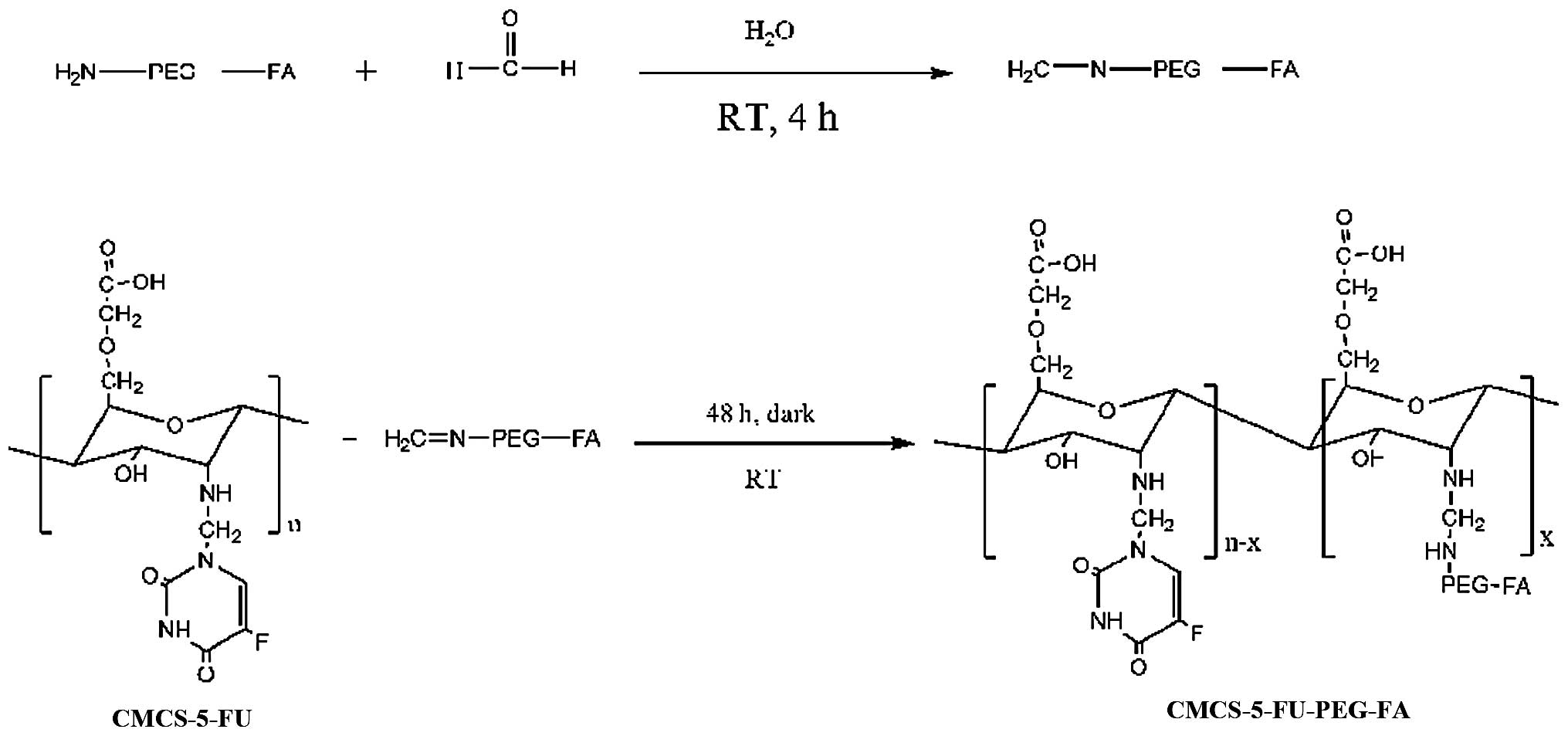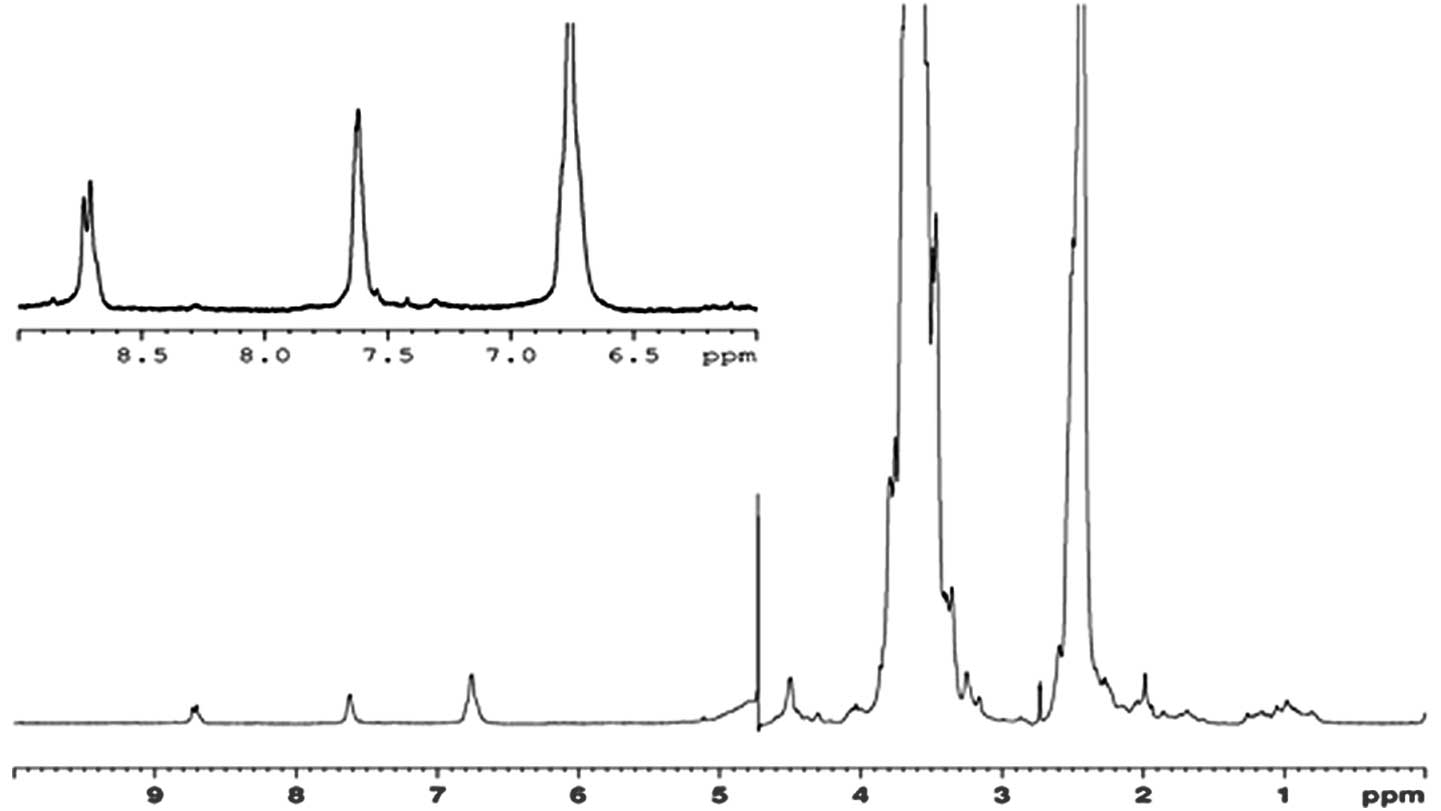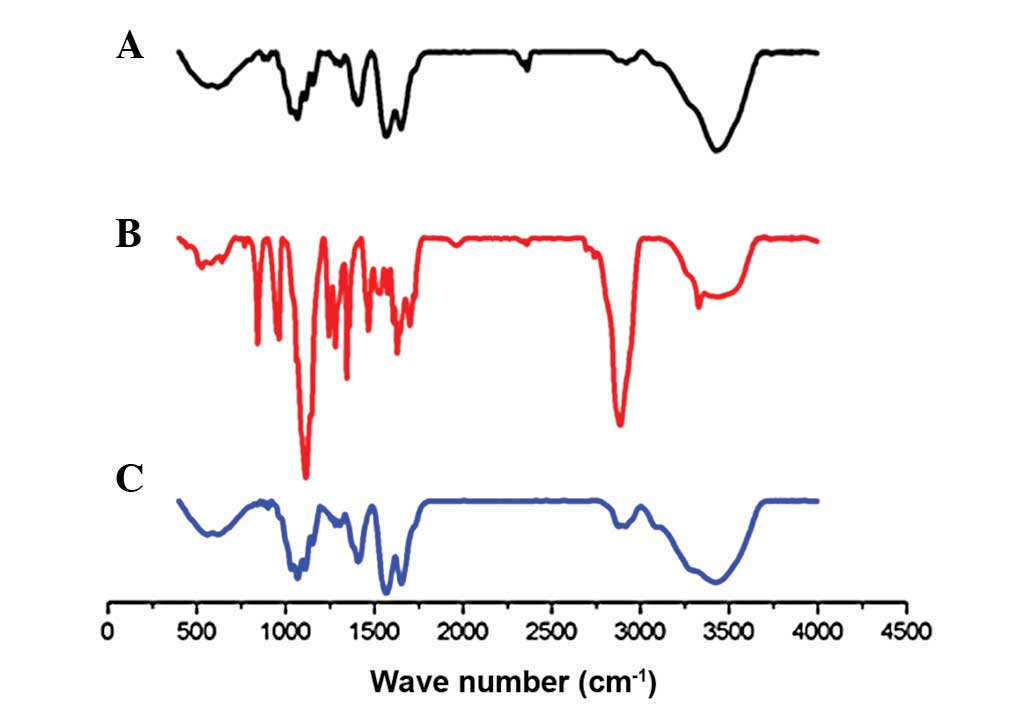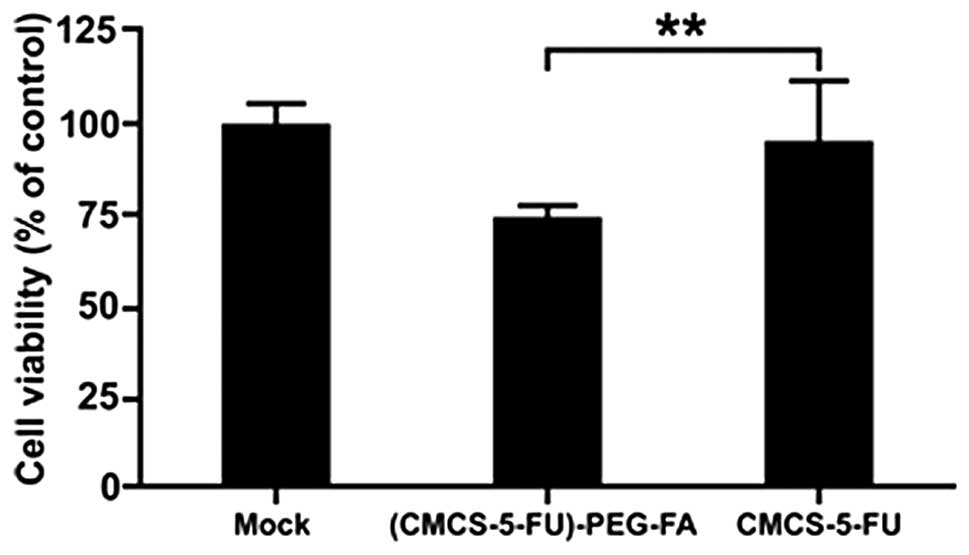Folate‑polyethylene glycol conjugated carboxymethyl chitosan for tumor‑targeted delivery of 5‑fluorouracil
- Authors:
- Published online on: January 23, 2014 https://doi.org/10.3892/mmr.2014.1917
- Pages: 786-792
Abstract
Introduction
Since its introduction by Heidelberger et al (1), 5-fluorouracil (5-FU) has been clinically used in the treatment of a range of solid tumors, including breast cancers and cancers of the digestive organs (2), and has remained the only effective chemotherapy option available for the treatment of colorectal cancer (3). However, in clinical trials of 5-FU, significant adverse effects due to nonspecific activity have been reported (4). Furthermore, as it is degraded in the gastrointestinal tract, 5-FU shows incomplete and unpredictable absorption (4) and a plateau has been reached regarding the drug’s efficacy (5). As the number of cancer-related mortalities rises annually, researchers have been working on numerous approaches, including the use of prodrugs (6,7), pH-sensitive polymer coating (8,9) and time-dependent formulations (10,11), in an attempt to identify novel 5-FU carrier systems with more powerful antitumor activity and reduced side effects (12,13). In previous years, 5-FU carrier systems that release 5-FU in situ have attracted the interest of researchers since such systems may circumvent the problem of oral administration of 5-FU in clinical applications (14,15). A number of biodegradable polymers, including azopolymer, pectin and dextrin (16,17), have been explored as potential carriers for 5-FU, and chitosan has emerged as one of the most promising.
Chitosan is composed of randomly distributed α-(1–4)-linked D-glucosamine and N-acetyl-D-glucosamine (18). It is generally considered an attractive drug vector due to its biodegradability, biocompatibility, hemostatic, bacteriostatic, fungistatic, anticancer and anticholesteremic properties, as well as its reasonable cost (19,20), minimum immunogenicity and low cytotoxicity (21). Furthermore, chitosan contains functional groups that allow simple coupling of extracellular and intracellular targeting ligands (22). However, its poor solubility limits its use as a drug delivery carrier. Therefore, the development of water-soluble chitosan is a prerequisite to its successful implementation in drug delivery (23). Various approaches, including quaternization of the amino group, N-carboxymethylation and PEGylation (24,25), have been adopted to improve the water solubility of chitosan. The anionic natural polymer derivative carboxymethyl chitosan (CMCS) meets the two main requirements for a drug carrier, biodegradability and low toxicity, and may be a promising potential cancer therapy in the future. However, as CMCS is a negatively charged macromolecule, it has difficulty attaching to the negatively-charged cell membrane for internalization. In vivo studies have shown that a near-neutral polyplex surface is important to minimize the occurrence of nonspecific interactions in the blood, and to allow the vector to circulate longer in order to reach its target. Thus, it is necessary to attach hydrophilic agents to the polyplex surface to reduce the surface charge and ensure steric stabilization.
It is well-documented that PEG shielding improves circulation time and reduces toxicity (26,27). Furthermore, it has been reported that polyplex PEG chains are capable of reducing interactions with blood and extracellular components (28,29). However, a number of disadvantages have also been reported, including reduced association with cells, diminished cellular uptake and inefficient cell transfection (30,31). Adding targeting ligands to polyplexes has been proposed as an attractive strategy to improve transfection efficiency (32,33). The major advantage of using chitosan as a drug carrier is that it may be easily conjugated to targeting agents, including proteins, transferrin (34), mannose (35–37), folate (38,39) and galactose (40–43).
A number of characteristics render folate acid (FA) an attractive candidate for targeted molecular treatment of tumors. Folate receptors (FR) exhibit limited expression in healthy cells, but are overexpressed on the surface of human cancer cells (44,45). Furthermore, the high affinity of folate to its receptor (45), and its small size, render it eligible for specific cell targeting. Additionally, the ability of FA to bind to its receptor and induce endocytosis is not altered by covalent bonding of small molecules (46). Studies have been conducted that have utilized FRs on the surface of tumor cells for targeted delivery of anticancer drugs, genes and radiopharmaceuticals via FR-mediated endocytosis (47,48). FA has also been used as a ligand with cationic liposomes (49) and other polymers, including chitosan (38,50), poly (L-lysine) (51,52), and polyethyleneimine (53). One study showed that FA may facilitate nanoparticle endocytosis via the FR, resulting in higher transfection yields (38). In addition, it has also been demonstrated that target-specific gene delivery may be enhanced by folate-PEG modified PEI in vitro and in vivo (54–57) with superior performance compared with PEI (54,56). Previously, Benns et al achieved a notable antitumor effect through intro-tumor administration of therapeutic genes carried by folate-PEG-PEI (55).
In the current study, 5-FU loaded and folate-conjugated CMCS were synthesized and characterized with a PEG spacer (CMCS-5-FU-PEG-FA). 5-FU coupled to CMCS was quantified using fluorine element analysis. The cytotoxicity of CMCS and CMCS-5-FU and the potential of CMCS-PEG-FA for use in targeted delivery of 5-FU in vitro were studied. The results showed that 5-FU and folate were successfully coupled to CMCS and that CMCS-g-PEG-folate is a promising non-viral vector for targeted delivery of chemotherapeutic agents to tumors. Future clinical applications the CMCS-5-FU-PEG-FA system is likely to aid in the goal of releasing 5-FU in situ to treat cancer.
Materials and methods
Materials
CMCS (Mw, 10,000–30,000 Da) was purchased from Sigma-Aldrich (Shanghai, China). NH2-PEG-FA (Mn, 3,400 Da) was provided by Jiaerke Co (Changzhou, China). Dialysis tubing with a Mw cut-off of 500–1,000 Da was purchased from Spectrum Laboratories (Miami, FL, USA). Cell culture media and supplements, fetal bovine serum (FBS), alamarBlues, FA dihydrate and other general-use chemicals were all purchased from Sigma-Aldrich. Unless stated otherwise, all reagents and solvents were commercially available analytic-grade reagents and were used without further purification.
Synthesis of CMCS-5-FU
Solutions of CMCS in distilled water and 5-FU in anhydrous dimethylsulfoxide (DMSO) were respectively prepared and stirred at 55ºC until CMCS and 5-FU were dissolved completely. Formaldehyde was then added to the solution of 5-FU in anhydrous DMSO. The mixture was stirred at 55ºC in the dark for 4 h, then added to the solution of CMCS in distilled water and stirred at room temperature for 24 h. Subsequently, the reaction mixture was dialyzed (cellulose acetate with a molecular weight cut off of 8,000–14,000 Da) against water for two days. The resultant product was collected by lyophilization (Fig. 1).
Synthesis of CMCS-g-PEG-folate (CMCS-PEG-FA)
Solutions of NH2-PEG-FA and CMCS in distilled water were respectively prepared and stirred at room temperature until NH2-PEG-FA was dissolved completely. Excessive stoichiometric formaldehyde was added to the solution of NH2-PEG-FA in distilled water. The resulting mixture was stirred at room temperature in the dark for 4 h, and then dialyzed against distilled water for 24 h using dialysis tubing with an Mw cut-off of 500–1,000 Da (Spectrum Laboratories, Rancho Dominguez, CA, USA) to separate free formaldehyde. Finally, the dialyzed solution was added to the solution of CMCS in distilled water and stirred at room temperature for 48 h. The resultant product was isolated using dialysis tubing with an Mw cut-off of 8,000–12,000 Da (Spectrum Laboratories) for 48 h, followed by freeze drying (Fig. 2).
Synthesis of CMCS-5-FU conjugated PEG-FA (CMCS-5-FU-PEG-FA)
Solutions of CMCS-PEG-FA in distilled water and 5-FU in anhydrous DMSO were respectively prepared and stirred at 55ºC until CMCS-PEG-FA and 5-FU were dissolved completely. Chemically quantified formaldehyde was then added to the solution of 5-FU in anhydrous DMSO. The resulting mixture was stirred at 55ºC in the dark for 4 h, and then added to the solution of CMCS-PEG-FA in distilled water and stirred at room temperature for 24 h. The resultant product was isolated using dialysis tubing with a Mw cut-off of 8,000–12,000 Da (Spectrum Laboratories) for 48 h, followed by freeze drying (Fig. 3).
Infrared (IR) spectroscopy
Fourier transform IR spectra of CMCS-PEG-FA, CMCS and H2N-PEG-FA were measured over 4,000–400 cm−1 on a Perkin-Elmer Spectrum 2000 instrument (Perkin Elmer, Boston, MA, USA) with KBr sample pellets.
Determination of 5-FU
The extent of 5-FU on CMCS-PEG-FA was evaluated using fluorine element analysis. Briefly, a 100 mg sample was wrapped in ashless paper and placed in a 500 ml oxygen flask containing 5 ml absorbing liquid for combustion. Fluorides in the resultant absorbing liquid were separated using IonPac AS14-AG14 (Dionex, Sunnyvale, CA, USA) as a separating column and rinsing with solution containing 0.001 M NaHCO3 + 0.0035 M Na2CO3. The electric conductivity was detected.
1H nuclear magnetic resonance (NMR) spectra
The CMCS-PEG-folate structure was confirmed by NMR. The 1H NMR spectra was recorded in D2O on a Bruker AC 200P, 200 MHz spectrometer (Bruker Corporation, Rheinstetten, Germany), using tetramethylsilane as the internal standard.
Cell culture
AGS, A549, HepG2 and HeLa cell lines were purchased from the Institute of Biochemistry and Cell Biology, Shanghai Institute for Biological Sciences (Chinese Academy of Sciences, Shanghai, China). AGS cells were cultured in 90% Ham’s F-12K medium supplemented with 10% heat-inactivated FBS (Gibco-BRL, Gaithersburg, MD, USA), 2 mM L-glutamine and 1.5 g/l Na2CO3. A549 cells were cultured in medium supplemented with 10% heat-inactivated FBS, 2 mM L-glutamine and 1.5 g/l NaHCO3. HepG2 were cultured in medium supplemented with 10% heat-inactivated FBS, 1.0 mM sodium pyruvate, 0.1 mM unessential amino acid and 1.5 g/l NaHCO3. HeLa cells were cultured in Dulbecco’s modified Eagle’s medium (DMEM) supplemented with 10% heat-inactivated FBS, 4 mM glutamine, 50 U/ml penicillin, and 50 mg/ml streptomycin (cell culture medium). All cells were cultured in a fully humidified atmosphere containing 5% CO2 at 37ºC.
In vitro cytotoxicity assay
HeLa, A549, HepG2 and AGS cell lines were seeded in a 24-well plate at a density of ~3.0×104 cell/ml and incubated overnight at 37ºC and 5% CO2 to attain subconfluence prior to infection with CMCS or CMCS-5-FU at various concentrations. Three days following infection, cells in each well were exposed to 0.4 ml 2% crystal violet in 20% methanol for 30 min at room temperature and rinsed with distilled water in preparation for image capturing.
Cellular evaluation of CMCS-PEG-FA targeting ability
The cell-targeting ability of 5-FU-loaded CMCS-PEG-FA was evaluated using HeLa cells, which overexpress the FR, using an 3-(4,5-dimethylthiazol-2-yl)-2,5-diphenyltetrazolium bromide (MTT) assay. HeLa cells were seeded in 96-well plates at a density of 1×104 cells/well in 100 μl cell culture medium and incubated overnight to obtain 75–80% confluency. The culture medium was then replaced with fresh, serum-free medium, and a serial sample of 5-FU-CMCS or 5-FU-CMCS-PEG-FA was added to the cells. Cells were incubated with 5-FU-CMCS or 5-FU-CMCS-PEG-FA at a concentration of 1 mg/ml with respect to the originally seeded cells at 37ºC. Cells were incubated for a further 72 h. A total of 10 μl MTT solution (5 mg/ml) was added to the 100 μl of culture medium in each well prior to incubation at 37ºC for 4 h. The MTT-containing medium was replaced with 100 μl solubilization solution DMSO. Finally, the absorbance was measured at 595 nm using an ELISA plate reader (Thermo Fisher, Waltham, MA, USA) with a reference filter of 650 nm. Viability of non-treated control cells was arbitrarily defined as 100%. The experiment was repeated three times for each sample treatment. Cell viability (%) was calculated from the following equation (i): [OD595(sample)-OD595(sample)]/[OD595(control)-OD650(control)] ×100, (i) where OD595(sample) and OD650(sample) represent measurements from the wells treated with CMCS-5-FU or (CMCS-5-FU)-PEG-FA complex and OD595(control) and OD650(control) represent measurements from the wells treated with only DMEM containing 10% fetal calf serum.
Statistical analysis
All experiments were repeated four times and measurements were collected in quadruplicate. Data are expressed as the mean ± standard deviation based on four measurements. Statistical analysis was performed using Student’s t-test. P<0.005 was considered to indicate a statistically significant difference.
Results and discussion
Synthesis and characterization of CMCS-5-FU, CMCS-PEG-FA and CMCS-5-FU-PEG-FA
The analysis by 1H NMR (Fig. 4) confirmed the structure of the expected poly-CMCS-PEG-folate copolymer. Fig. 1 shows the 1H NMR spectrum of the poly-CMCS-PEG-folate copolymer. From the result of 1H NMR spectrum, it was observed that the peak at 3.54 ppm was assigned to the protons in the ethylene groups -O-CH2-CH2-O- of the PEG units. The signal appeared at 2.95–3.10 was corresponding to the monosaccharide residue (-CH-NH-). The signal at 2.45–2.60 ppm was attributed to the signal of -NH-CH2-CH2O-. It is evident that the proton peaks of 6.7–8.8 ppm were observed in the 1HNMR spectrum of CMCS-PEG-FA, confirming the successful conjugation of H2N-PEG-FA with CMCS. These results obtained are consistent with the expected chemical structure of the copolymers. The relevant signals of folate were weaker than the broad and marked proton signals of PEG and CMCS residues, producing more accurate evaluations. IR spectroscopy was performed to further confirm the successful coupling of NH2-PEG-folate to CMCS. The content of coupled 5-FU was determined by fluorine element analysis.
IR spectroscopy
The formation of CMCS-PEG-folate was confirmed using Fourier transform infrared spectroscopy. IR spectra in the amino group and hydroxyl group stretching region of CMCS, NH2-PEG-folate and CMCS-PEG-FA systems, with or without reaction, are presented in Fig. 2. Characteristics of IR bands of H-form CMCS is shown in Fig. 5A. The peaks at 1,652.62 cm−1 (-COOH), 1,031.08–1,153.05 cm−1 (C-O) indicated the characteristics of O-CMCS. The IR spectrum of NH2-PEG-FA (Fig. 5B) revealed peaks at 3328.39 cm−1 (N-H stretch), 1280.71 cm−1 (O-H deflection), 2885.46 cm−1 (C-H stretch), 1243.40 cm−1 (C-O deflection) and 1114.18 cm−1 (marked peak of C-O stretch of ether). Following the conjugation of FA-PEG-NH2 with CMCS, the spectrum of the resultant molecules (Fig. 5C) shows the characteristic bands of the original CMCS and also the characteristic peaks of the FA at 1,652.62 cm−1 (-CONH amide band II) and 1,568.08 cm−1 (-NH amide band II) (Fig. 5C). Furthermore, the absorption of amide band II at 1,652.62 cm−1 increased. Bands at 1698.70 cm−1 were due to the C=O stretching vibration of carboxylic acid in FA and bands between 1155.26 and 1068.12 cm−1 were attributed to the C-O-C stretching vibration of ether in CMCS, demonstrating that CH2=N-PEG-FA binds chemically to CMCS. A marked modification of the absorption pattern was observed, where the typical hydroxyl group and amino group stretching band at 3423.73 cm−1 appeared markedly reduced, demonstrating the substitution of H in the hydroxyl or amino group on the CMCS by N of the NH2-PEG-FA or 5-FU.
Determination of 5-fluorouracil content
To determinate the percentage of 5-FU grafted to (CMCS-5-FU)-PEG-FA, the fluorine element analysis was conducted following freeze drying of the conjugate. The result obtained indicated that there was 0.332 mg 5-FU in 1 g (CMCS-5-FU)-PEG-FA.
In vitro cytotoxicity of CMCS-5-FU and CMCS
For the concerns of efficient drug delivery, biocompatibility and cytotoxicity of the CMCS or 5-FU loaded CMCS, four cell lines (AGS, SW480, HeLa and A549) were selected for the in vitro cytotoxicity investigation using the crystal violet assay. The cells were incubated with CMCS or 5-FU loaded CMCS in the medium for 72 h. Crystal violet stain was used to assay cell viabilities in the presence of CMCS or 5-FU loaded CMCS, using cells untreated with CMCS or 5-FU loaded CMCS as the control.
As illustrated in Fig. 6, for CMCS, cell viabilities are ~100%, which indicates that there is no cytotoxicity of CMCS against the four selected cell lines AGS, A549, HeLa and HepG2, and the results obtained were consistent with the reported results in the literature that demonstrated that chitosan exhibits no toxicity in in vitro (58) and in vivo (22) experiments. However, 5-FU loaded CMCS Exhibited a marked inhibitive effect on AGS, A549, HeLa and HepG2 cell lines, suggesting that the powerful antitumor potential is retained when 5-FU is covalently linked to CMCS and maintains the antitumor ability. Furthermore, at the same concentration, there was an extent of difference in the cytotoxicity of 5-FU loaded CMCS to the four cancer cell lines selected, indicating that the antitumor ability of 5-FU loaded CMCS has an association with cancer cell types. In conclusion, 5-FU was successfully linked to CMCS and 5-FU covalent linkage with CMCS did not affect its antitumor potential.
Cellular evaluation of CMCS-PEG-FA targeting ability
To determine whether folate acid conjugated with CMCS may effectively target and improve of the rate of drug uptake by cancer cells, in vitro targeted delivery of 5-FU was investigated by MTT assay in FR+ HeLa cells with phosphate-buffered saline as the control.
The results of the MTT assay revealed that differences in cytotoxicity between CMCS-5-FU and CMCS-5-FU-PEG-FA were significantly larger for FR+ HeLa cell lines (Fig. 7). These results may be attributed to the involvement of the FR in cellular association and endocytosis of CMCS-5-FU-PEG-FA in FR+ cells.
In conclusion, in the current study, 5-FU and FA-PEG-NH2 were successfully grafted onto CMCS. CMCS showed no toxicity against HeLa, AGS, A549 or HepG2 cells. The feasibility of using CMCS-PEG-folate to deliver 5-FU in a targeted manner to FR-bearing HeLa cancer cells was confirmed. FA-PEG-CMCS may be a promising carrier for the targeted delivery of chemotherapeutic agents to FR-bearing tumor cells. Further studies are in progress in our laboratory to test this novel targeted drug delivery system in vivo.
Acknowledgements
The authors would like to thank Professor Lanyin Sun for her technical assistance, Mr. Zewen Ye for 1H NMR spectrum and IR spectroscopy analyses, Mr. Xing Ze for illustration, and Dr Guoxin Zhang, Dr Mouhua Wang and Dr Weihua Liu for discussions. Professional English proof reading by Mrs. Sarash is also acknowledged.
References
|
Heidelberger C, Chaudhuri NK, Danneburg P, et al: Fluorinated pyrimidines, a new class of tumour-inhibitory compounds. Nature. 179:663–666. 1957. View Article : Google Scholar : PubMed/NCBI | |
|
Cai TB, Tang X, Nagorski J, Brauschweiger PG and Wang PG: Synthesis and cytotoxicity of 5-fluorouracil/diazeniumdiolate conjugates. Bioorg Med Chem. 11:4971–4975. 2003. View Article : Google Scholar : PubMed/NCBI | |
|
No authors listed. Efficacy of adjuvant fluorouracil and folinic acid in colon cancer. International Multicentre Pooled Analysis of Colon Cancer Trials (IMPACT) investigators. Lancet. 345:939–944. 1995. View Article : Google Scholar : PubMed/NCBI | |
|
Lin FH, Lee YH, Jian CH, Wong JM, Shieh MJ and Wang CY: A study of purified montmorillonite intercalated with 5-fluorouracil as drug carrier. Biomaterials. 23:1981–1987. 2002. View Article : Google Scholar : PubMed/NCBI | |
|
Bleiberg H: Colorectal cancer - is there an alternative to 5-FU? Eur J Cancer. 33:536–541. 1997. View Article : Google Scholar : PubMed/NCBI | |
|
Riley SA and Turnberg LA: Sulphasalazine and the aminosalicylates in the treatment of inflammatory bowel disease. Q J Med. 75:551–562. 1990.PubMed/NCBI | |
|
Bartalsky A: Salicylazobenzoic acid in ulcerative colitis. Lancet. 319:9601982. View Article : Google Scholar | |
|
Ashford M, Fell J, Attwood D, Sharma H and Woodhead P: In vitro investigation into the suitability of pH dependent polymer for colonic targeting. Int J Pharm. 95:193–199. 1993. View Article : Google Scholar | |
|
Marvola M, Nykänen P, Rautio S, Isonen N and Autere AM: Enteric polymers as binders and coating materials in multiple-unit site-specific drug delivery systems. Eur J Pharm Sci. 7:259–267. 1999. View Article : Google Scholar : PubMed/NCBI | |
|
Gazzaniga A, Busetti C, Sangali ME and Giordana ME: Time-dependent oral delivery system for colonic targeting system for the colon targeting. STP Pharma Sci. 5:83–88. 1995. | |
|
Gazzaniga A, Iamartino P, Maffione G and Sangal ME: Oral delayed release system system for colonic specific delivery. Int J Pharm. 108:77–83. 1994. View Article : Google Scholar | |
|
Malet-Martino M and Martino R: Clinical studies of three oral prodrugs of 5-fluorouracil (capecitabine, UFT, S-1): a review. Oncologist. 7:288–323. 2002. View Article : Google Scholar : PubMed/NCBI | |
|
Malet-Martino M, Jolimaitre P and Martino R: The prodrugs of 5-fluorouracil. Curr Med Chem Anticancer Agents. 2:267–310. 2002. View Article : Google Scholar | |
|
Haller DG: An overview of adjuvant therapy for colorectal. Eur J Cancer. 31A:1255–1263. 1995. View Article : Google Scholar : PubMed/NCBI | |
|
Bajetta E, Di Bartolomeo M, Somma L, Del Vecchio M, Artale S, Zunino F, Bignami P, Magnani E and Buzzoni R: Doxifluridine in colorectal cancer patients resistant to 5-fluorouracil (5-FU) containing regimens. Eur J Cancer. 33:687–690. 1997. View Article : Google Scholar : PubMed/NCBI | |
|
Hovgaard L and Brondsted H: Dextran hydrogels for colon-specific drug delivery. J Control Release. 36:159–166. 1995. View Article : Google Scholar | |
|
Watts PJ and Lllum L: Colonic drug delivery. Drug Dev Ind Pharm. 23:893–913. 1997. View Article : Google Scholar | |
|
Saranya N, Moorthi A, Saravanan S, Devi MP and Selvamurugan N: Chitosan and its derivatives for gene delivery. Int J Biol Macromol. 48:234–238. 2011. View Article : Google Scholar : PubMed/NCBI | |
|
Lee KY, Kwon IC, Kim YH, Jo WH and Jeong SY: Preparation of chitosan self-aggregates as a gene delivery system. J Control Release. 51:213–220. 1998. View Article : Google Scholar : PubMed/NCBI | |
|
Hejazi R and Amiji M: Chitosan-based gastrointestinal delivery system. J Control Release. 89:151–165. 2003. View Article : Google Scholar : PubMed/NCBI | |
|
Mansouri S, Lavigne P, Corsi K, Benderdour M, Beaumont E and Fernandes JC: Chitosan-DNA nanoparticles as non-viral vectors in gene therapy: strategies to improve transfection efficacy. Eur J Pharm Biopharm. 57:1–8. 2004. View Article : Google Scholar : PubMed/NCBI | |
|
Dang JM and Leong KW: Natural polymers for gene delivery and tissue engineering. Adv Drug Deliv Rev. 58:487–499. 2006. View Article : Google Scholar : PubMed/NCBI | |
|
Chung YC, Kuo CL and Chen CC: Preparation and important functional properties of water-soluble chitosan produced through Maillard reaction. Bioresour Technol. 96:1473–1482. 2005. View Article : Google Scholar | |
|
Liu WG, Zhang X, Sun SJ, Sun GJ, Yao KD, Liang DC, Guo G and Zhang JY: N-alkylated chitosan as a potential nonviral vector for gene transfection. Bioconjug Chem. 14:782–789. 2003. View Article : Google Scholar : PubMed/NCBI | |
|
Mao S, Shuai X, Unger F, Wittmar M, Xie X and Kissel T: Synthesis, characterization and cytotoxicity of poly(ethylene glycol)-graft-trimethyl chitosan block copolymers. Biomaterials. 26:6343–6356. 2005. View Article : Google Scholar : PubMed/NCBI | |
|
Gref R, Lück M, Quellec P, Marchand M, Dellacherie E, Harnisch S, et al: ‘Stealth’ corona-core nanoparticles surface modified by polyethylene glycol (PEG): influences of the corona (PEG chain length and surface density) and of the core composition on phagocytic uptake and plasma protein adsorption. Colloids Surf B Biointerfaces. 18:301–313. 2000. | |
|
Kircheis R, Schüller S, Brunner S, Ogris M, Heider KH, Zauner W, et al: Polycation-based DNA complexes for tumor-targeted gene delivery in vivo. J Gene Med. 1:111–120. 1999. View Article : Google Scholar : PubMed/NCBI | |
|
Ogris M, Brunner S, Schuller S, Kircheis R and Wagner E: PEGylated DNA/transferrin-PEI complexes: reduced interaction with blood components, extended circulation in blood and potential for systemic gene delivery. Gene Ther. 6:595–605. 1999. View Article : Google Scholar : PubMed/NCBI | |
|
Oupický D, Ogris M and Seymour LW: Development of long-circulating polyelectrolyte complexes for systemic delivery of genes. J Drug Target. 10:93–98. 2002.PubMed/NCBI | |
|
Nguyen HK, Lemieux P, Vinogradov SV, Gebhart CL, Guérin N, Paradis G, et al: Evaluation of polyether-polyethyleneimine graft copolymers as gene transfer agents. Gene Ther. 7:126–138. 2000. View Article : Google Scholar : PubMed/NCBI | |
|
Choi YH, Liu F, Kim JS, Choi YK, Park JS and Kim SW: Polyethylene glycol-grafted poly-L-lysine as polymeric gene carrier. J Control Release. 54:39–48. 1998. View Article : Google Scholar : PubMed/NCBI | |
|
Fernandez-Megia E, Novoa-Carballal R, Quiñoá E and Riguera R: Conjugation of bioactive ligands to PEG-grafted chitosan at the distal end of PEG. Biomacromolecules. 8:833–842. 2007. View Article : Google Scholar : PubMed/NCBI | |
|
Ogris M, Walker G, Blessing T, Kircheis R, Wolschek M and Wagner E: Tumor-targeted gene therapy: strategies for the preparation of ligand-polyethylene glycol-polyethylenimine/DNA complexes. J Control Release. 91:173–181. 2003. View Article : Google Scholar : PubMed/NCBI | |
|
Mao HQ, Roy K, Troung-Le VL, Janes KA, Lin KY, Wang Y, et al: Chitosan-DNA nanoparticles as gene carriers: synthesis, characterization and transfection efficiency. J Control Release. 70:399–421. 2001. View Article : Google Scholar : PubMed/NCBI | |
|
Kim TH, Nah JW, Cho MH, Park TG and Cho CS: Receptor-mediated gene delivery into antigen presenting cells using mannosylated chitosan/DNA nanoparticles. J Nanosci Nanotechnol. 6:2796–2803. 2006. View Article : Google Scholar : PubMed/NCBI | |
|
Hashimoto M, Morimoto M, Saimoto H, Shigemasa Y, Yanagie H, Eriguchi M and Sato T: Gene transfer by DNA/mannosylated chitosan complexes into mouse peritoneal macrophages. Biotechnol Lett. 28:815–821. 2006. View Article : Google Scholar : PubMed/NCBI | |
|
Wada K, Arima H, Tsutsumi T, Chihara Y, Hattori K, Hirayama F and Uekama K: Improvement of gene delivery mediated by mannosylated dendrimer/alpha-cyclodextrin conjugates. J Control Release. 104:397–413. 2005. View Article : Google Scholar : PubMed/NCBI | |
|
Mansouri S, Cuie Y, Winnik F, Shi Q, Lavigne P, Benderdour M, et al: Characterization of folate-chitosan-DNA nanoparticles for gene therapy. Biomaterials. 27:2060–2065. 2006. View Article : Google Scholar : PubMed/NCBI | |
|
Lee D, Lockey R and Mohapatra S: Folate receptor-mediated cancer cell specific gene delivery using folic acid-conjugated oligochitosans. J Nanosci Nanotechnol. 6:2860–2866. 2006. View Article : Google Scholar : PubMed/NCBI | |
|
Murata J, Ohya Y and Ouchi T: Design of quaternary chitosan conjugate having antennary galactose residues as a gene delivery tool. Carbohydr Polym. 32:105–119. 1997. View Article : Google Scholar | |
|
Gao S, Chen J, Xu X, Ding Z, Yang YH, Hua Z and Zhang J: Galactosylated low molecular weight chitosan as DNA carrier for hepatocyte-targeting. Int J Pharm. 255:57–68. 2003. View Article : Google Scholar : PubMed/NCBI | |
|
Kim TH, Park IK, Nah JW, Choi YJ and Cho CS: Galactosylated chitosan/DNA nanoparticles prepared using water-soluble chitosan as a gene carrier. Biomaterials. 25:3783–3792. 2004. View Article : Google Scholar : PubMed/NCBI | |
|
Hashimoto M, Morimoto M, Saimoto H, Shigemasa Y and Sato T: Lactosylated chitosan for DNA delivery into hepatocytes: the effect of lactosylation on the physicochemical properties and intracellular trafficking of pDNA/chitosan complexes. Bioconjug Chem. 17:309–316. 2006. View Article : Google Scholar : PubMed/NCBI | |
|
Weitman SD, Lark RH, Coney LR, Fort DW, Frasca V, Zurawski VR Jr and Kamen BA: Distribution of the folate receptor GP38 in normal and malignant cell lines and tissues. Cancer Res. 52:3396–3401. 1992.PubMed/NCBI | |
|
Antony AC: Folate receptors. Annu Rev Nutr. 16:501–521. 1996. View Article : Google Scholar | |
|
Lee RJ and Low PS: Delivery of liposomes into cultured KB cells via folate receptor-mediated endocytosis. J Biol Chem. 269:3198–3204. 1994.PubMed/NCBI | |
|
Lee RJ and Low PS: Folate-mediated tumor cell targeting of liposome-entrapped doxorubicin in vitro. Biochem Biophys Acta. 1233:134–144. 1995. View Article : Google Scholar : PubMed/NCBI | |
|
Ross JF, Chaudhuri PK and Ratnam M: Differential regulation of folate receptor isoforms in normal and malignant tissues in vivo and in established cell lines. Physiologic and clinical implications. Cancer. 73:2432–2443. 1994. View Article : Google Scholar : PubMed/NCBI | |
|
Kamaly N, Kalber T, Thanou M, Bell JD and Miller AD: Folate receptor targeted bimodal liposomes for tumor magnetic resonance imaging. Bioconjug Chem. 20:648–655. 2009. View Article : Google Scholar : PubMed/NCBI | |
|
Zheng Y, Cai Z, Song X, Chen Q, Bi Y, Li Y and Hou S: Preparation and characterization of folate conjugated N-trimethyl chitosan nanoparticles as protein carrier targeting folate receptor: in vitro studies. J Drug Target. 17:294–303. 2009. View Article : Google Scholar | |
|
Hwa Kim S, Hoon Jeong J, Chul Cho K, Wan Kim S and Gwan Park T: Target-specific gene silencing by siRNA plasmid DNA complexed with folate-modified poly(ethylenimine). J Control Release. 104:223–232. 2005.PubMed/NCBI | |
|
Hwa Kim S, Hoon Jeong J, Co Joe and Gwan Park T: Folate receptor mediated intracellular protein delivery using PLL-PEG-FOL conjugate. J Control Release. 103:625–634. 2005.PubMed/NCBI | |
|
Liang B, He ML, Xiao ZP, et al: Synthesis and characterization of folate-PEG-grafted-hyperbranched-PEI for tumor-targeted gene delivery. Biochem Biophys Res Commun. 367:874–880. 2008. View Article : Google Scholar : PubMed/NCBI | |
|
Benns JM, Mahato RI and Kim SW: Optimization of factors influencing the transfection efficiency of folate-PEG-folate-graft-polyethylenimine. J Control Release. 79:255–269. 2002. View Article : Google Scholar : PubMed/NCBI | |
|
Benns JM, Maheshwari A, Furgeson DY, Mahato RI and Kim SW: Folate-PEG-folate-graft-polyethylenimine-based gene delivery. J Drug Target. 9:123–139. 2001. View Article : Google Scholar : PubMed/NCBI | |
|
Cheng H, Zhu JL, Zeng X, Jing Y, Zhang XZ and Zhuo RX: Targeted gene delivery mediated by folate-polyethylenimine-block-poly(ethylene glycol) with receptor selectivity. Bioconjug Chem. 20:481–487. 2009. View Article : Google Scholar : PubMed/NCBI | |
|
Kim SH, Mok H, Jeong JH, Kim SW and Park TG: Comparative evaluation of target-specific GFP gene silencing efficiencies for antisense ODN, synthetic siRNA, and siRNA plasmid complexed with PEI-PEG-FOL conjugate. Bioconjug Chem. 17:241–244. 2006. View Article : Google Scholar : PubMed/NCBI | |
|
Corsi K, Chellat F, Yahia L and Fernandes JC: Mesenchymal stem cells, MG63 and HEK293 transfection using chitosan-DNA nanoparticles. Biomaterials. 24:1255–1264. 2003. View Article : Google Scholar : PubMed/NCBI |



